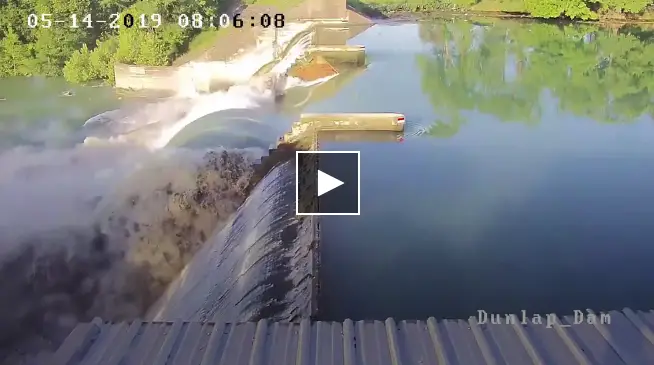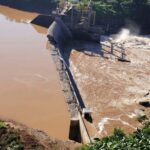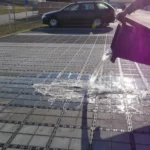Back in 2019, concerns over the aging dams prompted the Guadalupe-Blanco River Authority to make a challenging decision that significantly impacted the landscape – the draining of four beloved lakes: Lake Gonzales, Meadow Lake, Lake Placid, and Lake McQueeney.
The process of dewatering began on September 16, starting with Lake Gonzales and proceeding upstream to Meadow Lake, then Lake Placid, culminating with Lake McQueeney. This decision, while unpopular, was driven by the paramount importance of safety, considering the potential dangers associated with the aging dams, some of which were over 90 years old.
If you’re a dam owner equipped with the resources to strategically install cameras facing the reservoir, with a focus on capturing the dam crest, spillway crest, gates, chute, and plunge pool or discharge area, you are making a critical investment in dam safety. The recordings obtained during extreme events become invaluable tools for designers, enabling them to evaluate the actual performance of the spillway under real activation circumstances.
These recorded visuals offer a unique perspective that goes beyond theoretical assessments, providing an opportunity to scrutinize the dam’s behavior during challenging conditions. This is particularly crucial for identifying any flaws in design or construction, allowing for proactive measures to address issues before they escalate into safety risks.
As a dam owner, you recognize that sometimes electronic instruments, including cameras, serve as essential tools to supplement our human observations. The footage obtained from these cameras becomes a reliable source of information, aiding in the comprehensive monitoring of the dam’s various components and responses to environmental stressors.
It’s important to acknowledge that while cameras can provide valuable insights, they may not be sufficient for detecting certain issues such as corrosion and slow degradation. Therefore, integrating a robust dam safety program involves using a combination of electronic instruments and cameras. This approach ensures a more comprehensive monitoring strategy, covering both visible and hidden aspects of dam health.
The example of the Thaum Sauk Pumped Storage upper reservoir failure in 2005 in Lesterville, MO, serves as a stark reminder of the consequences of failed sensors combined with an aging dam. The subsequent rebuilding of the reservoir using Roller Compacted Concrete (RCC) highlights the importance of learning from such incidents and implementing measures to enhance dam safety.
In conclusion, your commitment to utilizing electronic instruments and cameras as integral components of dam safety not only aligns with industry best practices but also exemplifies a proactive approach to risk management. These tools contribute significantly to the ongoing monitoring and assessment of dam health, ultimately supporting the overarching goal of ensuring the safety and integrity of these critical structures.

Each lake took approximately three days to drain, and by the end of September, the once-vibrant bodies of water became a memory. The aging hydroelectric dams, which had stood for decades, were the focal point of the concerns that led to this unprecedented action.
Like Us on Facebook!
A notable incident in May, when a partial dam failure at Lake Dunlap was captured on video, underscored the urgency of addressing the aging infrastructure. The video depicted water rushing out of the lake at a staggering rate of 11,000 cubic feet per second.
Subscribe Us on YouTube!
The Guadalupe-Blanco River Authority, led by General Manager and CEO Kevin Patteson, expressed its commitment to prioritizing safety. The decision to drain the lakes was deemed unavoidable, and efforts were made to work closely with lake associations, the community, and affected residents to mitigate the impact.
Property owners expected to be affected by the draining were contacted by GBRA, showcasing a proactive approach to addressing the consequences of this monumental decision. To enhance public safety, GBRA implemented various measures, including signage near buoys, cameras, and sirens around dams to warn people of the potential hazards posed by the aging dams.
GBRA observed that, despite these efforts, there were instances of people entering restricted areas close to the dams, intensifying public safety concerns. The monitoring systems in place captured footage of individuals within these restricted zones, emphasizing the risks associated with the aging infrastructure.
Collaboration with lake associations, residents, and county officials was initiated to determine the best course of action for identifying, funding, and completing the necessary replacement of the aging dams. The Guadalupe Valley Lakes website became a source for updates on the lake draining process and subsequent actions, offering transparency and information to the affected communities.
Some Recommendations & Lessons
If you’re a dam owner equipped with the resources to strategically install cameras facing the reservoir, with a focus on capturing the dam crest, spillway crest, gates, chute, and plunge pool or discharge area, you are making a critical investment in dam safety. The recordings obtained during extreme events become invaluable tools for designers, enabling them to evaluate the actual performance of the spillway under real activation circumstances.
These recorded visuals offer a unique perspective that goes beyond theoretical assessments, providing an opportunity to scrutinize the dam’s behavior during challenging conditions. This is particularly crucial for identifying any flaws in design or construction, allowing for proactive measures to address issues before they escalate into safety risks.
As a dam owner, you recognize that sometimes electronic instruments, including cameras, serve as essential tools to supplement our human observations. The footage obtained from these cameras becomes a reliable source of information, aiding in the comprehensive monitoring of the dam’s various components and responses to environmental stressors.
It’s important to acknowledge that while cameras can provide valuable insights, they may not be sufficient for detecting certain issues such as corrosion and slow degradation. Therefore, integrating a robust dam safety program involves using a combination of electronic instruments and cameras. This approach ensures a more comprehensive monitoring strategy, covering both visible and hidden aspects of dam health.
The example of the Thaum Sauk Pumped Storage upper reservoir failure in 2005 in Lesterville, MO, serves as a stark reminder of the consequences of failed sensors combined with an aging dam. The subsequent rebuilding of the reservoir using Roller Compacted Concrete (RCC) highlights the importance of learning from such incidents and implementing measures to enhance dam safety.
In conclusion, your commitment to utilizing electronic instruments and cameras as integral components of dam safety not only aligns with industry best practices but also exemplifies a proactive approach to risk management. These tools contribute significantly to the ongoing monitoring and assessment of dam health, ultimately supporting the overarching goal of ensuring the safety and integrity of these critical structures.




















